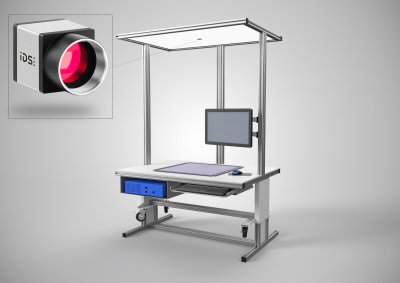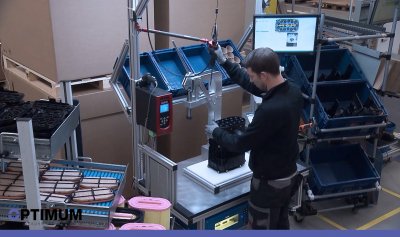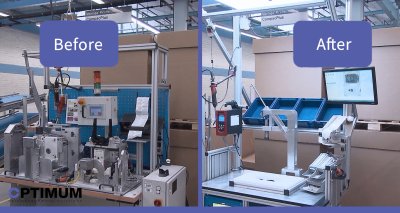Automation plays a major role in Industry 4.0. Cost reduction, increased productivity and zero-defect quality are factors that are increasingly prompting companies to digitalize their processes. But often full automation also means high investments.
 Intelligent Image Processing Supports Production Workers in Industrial 4.0 Applications
Intelligent Image Processing Supports Production Workers in Industrial 4.0 Applications

Case Study from | IDS Imaging Development Systems
At the same time, the focus will continue to be on the human being in the interaction between man and machine. Given the prevailing shortage of skilled workers and high standards of industrial safety, this is no easy task for companies. Additional challenges for a successful process optimization are a large number of variants, complex tasks and processes, as well as increasing quality requirements. How can this succeed?
With the assistance system "Clever Klaus", the German company OPTIMUM datamanagement solutions GmbH has developed a smart solution: The easy-to-integrate, camera-based assistant uses digitization to optimize and simplify manual inspection processes. By combining industrial image recognition using a high-resolution USB3 industrial camera from IDS and an intelligent database, the assistance system recognizes every step and assists the employee in real time during the entire assembly process. According to the simple principle: Instructing - checking - confirming - documenting even these complex processes become manageable.

Figure 1: "Clever Klaus" assembly assistance system with USB 3 uEye CP industrial camera from IDS
The intelligent assembly assistance system "Clever Klaus" guides employees step by step with digital assembly instructions. The worker scans the order document and the assembly process begins. An IDS camera installed above the work table records the workpiece or individual parts to be mounted. Both operating instructions and error messages appear on a touch monitor in real time: After each successful work step the worker receives a confirmation. Once assembly is complete, the system provides evidence of fault-free production.
"The camera generates the digital shadow", explains Wolfgang Mahanty, managing director of Optimum datamanagement solutions GmbH. All digital data of the process – when and how what is done - is recorded and processed. This enables the creation of a knowledge base and the subsequent transfer of knowledge to all. "The camera has to capture many details and a wide range of variations and provide stable images. Sensory recognition must be reliable, i.e. the sensor must be able to cope with poor or changing lighting conditions," says Mahanty, summarizing the demands on the camera. The reason: "In today's factory, the employee should get as much daylight as possible, which can affect the quality of the recording."
No problem for the USB3 industrial camera UI-3590CP from IDS. The light-sensitive AR1820HSSC00SHEA0 rolling shutter CMOS sensor from ON Semiconductor uses BSI ("back-side-illumination") technology to ensure outstanding image quality even in low light conditions. Even when capturing the smallest details, extremely high-resolution images with low image noise are produced. With a resolution of 18 MP (4912 x 3684) it reaches a frame rate of 21 fps. "Products are detected with deviations of 1mm on DINA 3", confirms Wolfgang Mahanty. Moreover, the small, compact size as well as the easy integration of the camera convinced the team of “Clever Klaus”.

Figure 2: The intelligent assembly assistance system "Clever Klaus" guides employees step by step with digital assembly instructions.
The German, Ludwigsburg-based company Mann + Hummel, world market leader and expert in the field of filtration, also appreciates the advantages of the assistance system optimized with the IDS camera model. Peter Sawatzky, Technical Manager at Mann + Hummel, also relies on the use of the "Clever Klaus". "During the final assembly of our filter components, many manual activities are required. This demands changing devices with very complex and therefore failure-prone sensory queries. The assistance system has convinced us because we make far fewer mistakes." New variants can be easily learned during work preparation and can be installed by the worker on the same day. "Our variant management has thus become much easier," underlines Sawatzky.

Figure 3: Easy integration into the respective production equipment, simplified variant management.
Additional benefit: The system can be integrated very easily into the respective production facility and even the use of several camera models is possible very simply and cost-effectively if the customer application requires it.
Employees learn new procedures quickly and safely with Klaus' help through the digital step-by-step instructions. The relief of the worker through the individual assembly assistance system as well as easier work organization allow a significant increase in productivity. Assembly costs are reduced, at the same time complaint costs are minimized by the increased quality assurance. "Since 'Clever Klaus' has been supporting our workers during assembly, the number of complaints has fallen significantly," confirms Sawatzky.
Outlook
Particularly in the electronics and automotive sectors, assistance systems such as the one from OPTIMUM datamanagement solutions GmbH are increasingly accelerating processes and ensuring increased efficiency and quality. Manufacturing processes run almost flawlessly, are fully documented and can be traced. In this way, they help companies to increase productivity and, if necessary, to gain a competitive advantage. Simple, intuitive operation is an important basis for the successful introduction of Industry 4.0 and the associated. Optimum is therefore constantly working on how the system can be easily taught. This is done using CAD data, intelligent filters or even artificial intelligence. A further step on the way to digitization is also the possibility of virtual commissioning. The assistance system must be designed so intuitively that every employee from the maintenance or work preparation department can operate it himself.
No doubt: Digitization is advancing all the time, and the need for solutions to increase efficiency and quality in the factory of the future is growing. With individual, easily integrated assistance systems and intelligent image processing, it can be covered quickly and easily. An investment that pays for itself in a short time.
The content & opinions in this article are the author’s and do not necessarily represent the views of RoboticsTomorrow

IDS Imaging Development Systems Inc.
World-class image processing and industrial cameras "Made in Germany". Machine vision systems from IDS are powerful and easy to use. IDS is a leading provider of area scan cameras with USB and GigE interfaces, 3D industrial cameras and industrial cameras with artificial intelligence. Industrial monitoring cameras with streaming and event recording complete the portfolio. One of IDS's key strengths is customized solutions. An experienced project team of hardware and software developers makes almost anything technically possible to meet individual specifications - from custom design and PCB electronics to specific connector configurations. Whether in an industrial or non-industrial setting: IDS cameras and sensors assist companies worldwide in optimizing processes, ensuring quality, driving research, conserving raw materials, and serving people. They provide reliability, efficiency and flexibility for your application.
Other Articles
2D cameras for positioning and inspecting ultra-fine wires in semiconductor production
Picking the right chart - (Semi-)Autonomous surface and underwater mapping for rivers and lakes
Pallet by pallet - Intelligent robotic vision system destacks up to 800 objects per hour
More about IDS Imaging Development Systems Inc.
Comments (0)
This post does not have any comments. Be the first to leave a comment below.
Featured Product

